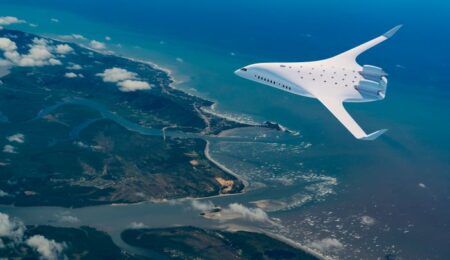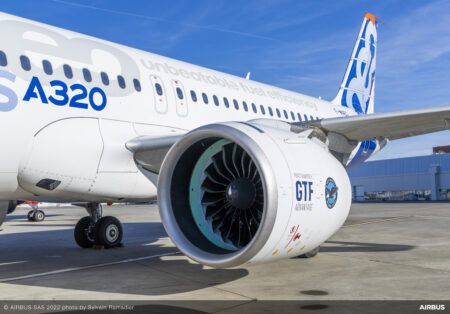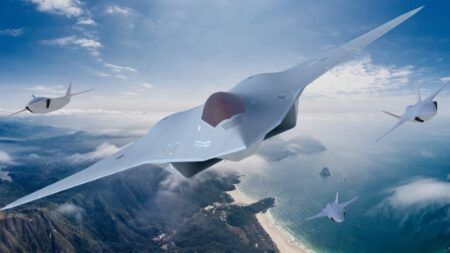Engineers at the Arnold Engineering Development Complex and US company MetroLaser are using a new type of laser measurement system to test the gas velocity of engine exhaust and help find ways to reduce noise from aircraft.
During November 2021, a team from MetroLaser used the J85 engine testbed maintained by Arnold Engineering Development Complex (AEDC) at the University of Tennessee Space Institute’s Propulsion Research Facility (PRF) near Arnold Air Force Base, Tennessee to study its three-component planar Doppler velocimetry (PDV), a system that enables optical, non-intrusive measurements of gas velocity in the exhaust of an engine.
Members of MetroLaser and the US Navy have partnered on several other programs with AEDC, which helped them in deciding to use the PRF for this particular research.
“The engine testbed facilities at the Propulsion Research Facility have been vital to the success of the MetroLaser SBIR program,” said David Mayo, a mechanical engineer with the US Navy and technical point of contact for MetroLaser. “The engineers and staff at the PRF have provided crucial support for the validation testing of MetroLaser’s PDV technology.”
Robert Howard, instrumentation and diagnostics subject matter expert, noted that MetroLaser and the Navy knew the PRF would be “an excellent, low-cost opportunity to demonstrate this measurement technique on a full-scale turbine engine.”
He added that the Navy’s interest in PDV stems from the need to understand the distribution of velocity in jet engine exhausts as a key to developing strategies for reducing noise from aircraft.
“Measurements are needed for comparison with engine exhaust flow-field models,” Howard said. “Current measurement methods involve intrusive probes or optical methods that require seeding the flow with particles. The optical method developed by MetroLaser relies on the soot particles already existing in the exhaust and, thus, makes this measurement technique more versatile for performing velocity measurements on engine stands and winged aircraft.”
With an expanded laser beam illuminating a swath of the exhaust’s flow field, the MetroLaser approach relies on measuring the scattered laser light with three strategically placed camera systems mounted outside the exhaust.
“Specialized iodine filters are then utilized to help discern the Doppler frequency shift of the scattered laser light illuminating the camera systems,” Howard said. “The shift in laser frequency results from the laser light being scattered from high velocity soot particles in the exhaust.”
Brad Besheres, AEDC J85 test operations engineer, mentioned the test conducted in November 2021 was actually the second of a two-phase effort in the process.
“In the fall of 2020, AEDC helped MetroLaser install and evaluate the performance of a basic laser and camera system comprising the components of the PDV system in the vicinity of the relatively harsh vibrating acoustic environment of the jet engine operated over its power range, from idle to afterburner operations,” Besheres said.
“The information and lessons learned from that test were used to design a mounting structure for the final demonstration, which led to a very successful test campaign that provided MetroLaser with ample data to declare a successful demonstration of the PDV system to their Navy sponsor.”
Tom Jenkins, president of MetroLaser, said the PDV technique was also previously used at the AEDC National Full-Scale Aerodynamics Complex in the NASA Ames Research Center in Mountain View, California. In the 80-by-120ft wind tunnel. The technique has been shown to be capable of resolving velocities as low as 2m per second from a single laser pulse and to be applicable at observation ranges exceeding 40m.
These capabilities, in addition to the minimal requirements of PDV on the optical features of the aerosols in the flow, make it a way to measure three-component velocity vector fields in time-dependent flows in large-scale wind tunnel facilities. A high-quality, three-camera PDV system was assembled and installed in the wind tunnel to allow flow field measurements between the moving rotor blades of a full-scale rotor.
PDV can also be applied to measurements of the motion of solid objects whenever there are unique advantages to the use of localized laser targeting and the spatial discrimination that is provided by velocity field images. Examples include the individual flight paths and spin or tumbling velocities of multiple targets, the local velocities of moving machinery parts, and the motion of biological targets.
In the case of measurements on solid objects where the path of the motion is known, only a single camera system is necessary to obtain the complete velocity along the trajectory and the laser illumination can be volumetric, rather than a light sheet.





